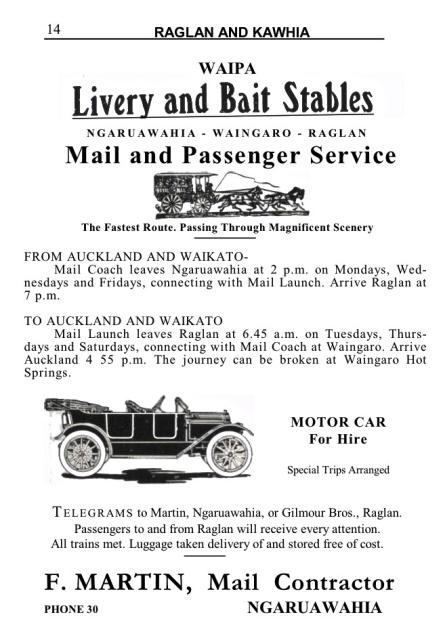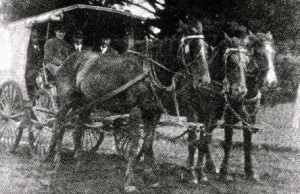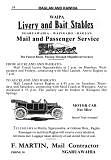
By John Lawson
1913 was a time of continuing what had already been started in Raglan Whaingaroa, rather than starting any new ventures. The Balkan wars were in the news every day and very often news of new German, British, or New Zealand armaments, or spies; the First World War was just a year away. The annual Military Ball was held in September in Te Mata and “several conveyances loaded with passengers went from Raglan.”
However, Raglan was becoming more of a holiday town. The Waikato Argus on 5 Feb reported that, “The Carnival Committee have erected a very satisfactory bathing enclosure and dressing sheds” and “the [Ngarunui] beach at the South Head is becoming a favourite place for picnics, and also the leading road to the Tattooed Rocks”. The deviation had just been opened, some of the road metalled, cars took just 3 hours and even the mail coach could now leave Raglan at 7am and be in Hamilton by 1pm, much quicker than the previous 7pm.
The Argus also said, “Motor cars are becoming quite a noticeable week-end feature, and visitors, in spite of the inclemency of the weather, are numerous.” That presumably explained why the statutory half holiday was changed by the Town Board from Saturday to Wednesday, which remained until repeal in 1977.
It also explained why 47 people signed a petition to restrict motor traffic to weekends and Mondays and why Raglan Chamber of Commerce asked for an 8mph limit on the deviation. By March Raglan County Council had agreed with the AA to put notices on bends and “Throughout that part of the road known as the new deviation, motorists to limit their speed to five miles an hour” and “the number of each car and the time of its passing to be left by the driver at the Waitetuna and Whatawhata post offices.” Also “The entrance to and exit from the town of Raglan to be via the town hill, keeping the ‘deviation’ clear of motor traffic”. By September the county adopted a by-law “applying to the portion of the Whatawhata to Raglan road known as the Deviation road, where it joins with Heddon’s road to the Waitetuna bridge, for the safety of traffic and stock.”

Those signing the petition would have been concerned at the very narrow road and the timid nature of many horses. In April Sydney Dando was closing Mr Rutherford’s gate (now Robertson St) on to the main road when his horses took off with his waggon and capsized over a bank, “but didn’t stop till they reached the foot of the town hill with just the forecarriage.” He and the horses were cut and bruised. Also in April, Bert Pegler’s cart was parked outside the butcher, when the noisy arrival of the mail coach startled the horses “which galloped into Cliff St, round another corner, and on up the road known as the deviation. Coach driver, Mr McKie, whipped out one of his leaders and galloped in the opposite direction round the block” and pulled on the brake.
‘Deviations’ were being built in many places. In 1913 the Council asked its engineer to report on the Kauroa deviation, despite opposition from 28 Okete ratepayers who wanted Okete Rd to remain the main route. Raglan Chamber of Commerce asked for a survey of the shortest route from Okete Bridge to Raglan.


Hi there we are related to George McKie and wondered if it was possible to get a better quality image of him on the mail coach?
Not aware of a better version of that one, but John Lawson has supplied details on other photos –
1907 Nov 21 coach going to St Albans Waingaro http://www.aucklandcity.govt.nz/dbtw-wpd/exec/dbtwpub.dll?BU=http%3A%2F%2Fwww.aucklandcity.govt.nz%2Fdbtw-wpd%2FHeritageImages%2Findex.htm&AC=QBE_QUERY&TN=heritageimages&QF0=ID&NP=2&MR=5&RF=HIORecordSearch&QI0=%3D%22AWNS-19071121-2-5%22
1908 Feb 20 AWN The mail coach on the Kawhia-Raglan road (I suspect Kawhia should read Ngaruawahia) http://www.aucklandcity.govt.nz/dbtw-wpd/exec/dbtwpub.dll?BU=http%3A%2F%2Fwww.aucklandcity.govt.nz%2Fdbtw-wpd%2FHeritageImages%2Findex.htm&AC=QBE_QUERY&TN=heritageimages&QF0=ID&NP=2&MR=5&RF=HIORecordSearch&QI0=%3D%22AWNS-19080220-3-1%22
Mail coach on the road between Ngaruawahia and Raglan, near Raglan, 1910 http://natlib.govt.nz/records/22787955
1911 Waingaro-Ngaruawahia coach http://www.aucklandcity.govt.nz/dbtw-wpd/exec/dbtwpub.dll?BU=http%3A%2F%2Fwww.aucklandcity.govt.nz%2Fdbtw-wpd%2FHeritageImages%2Findex.htm&AC=QBE_QUERY&TN=heritageimages&QF0=ID&NP=2&MR=5&RF=HIORecordSearch&QI0=%3D%224-2487%22
1912 Ngaruawahia to Raglan mail coach, taken by an unidentified photographer.jpg http://natlib.govt.nz/records/22777853